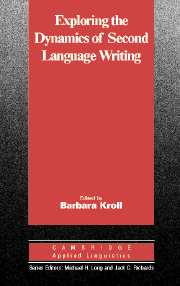Book contents
- Frontmatter
- Contents
- List of contributors
- Acknowledgments
- List of abbreviations used
- Series editors' preface
- Introduction: Teaching the next generation of second language writers
- I EXPLORING THE FIELD OF SECOND LANGUAGE WRITING
- II EXPLORING THE VOICES OF KEY STAKEHOLDERS:TEACHERS AND STUDENTS
- III EXPLORING WRITERS' FINISHED TEXTS
- IV EXPLORING CONTEXTUALITIES OF TEXTS
- V EXPLORING TECHNOLOGY
- EPILOGUE: EXPLORING OURSELVES
- Index
II - EXPLORING THE VOICES OF KEY STAKEHOLDERS:TEACHERS AND STUDENTS
Published online by Cambridge University Press: 05 October 2012
- Frontmatter
- Contents
- List of contributors
- Acknowledgments
- List of abbreviations used
- Series editors' preface
- Introduction: Teaching the next generation of second language writers
- I EXPLORING THE FIELD OF SECOND LANGUAGE WRITING
- II EXPLORING THE VOICES OF KEY STAKEHOLDERS:TEACHERS AND STUDENTS
- III EXPLORING WRITERS' FINISHED TEXTS
- IV EXPLORING CONTEXTUALITIES OF TEXTS
- V EXPLORING TECHNOLOGY
- EPILOGUE: EXPLORING OURSELVES
- Index
Summary
The desire to make sense of language teaching and language learning requires close study of both learners and teachers as well as the learning/ teaching situation itself. In a recent study of highly experienced English as a second language (ESL) teachers in Australia, for example, Breen et al. (2001) report on the relationships between teachers' actual classroom practices and the principles that they felt guided those practices. In a different type of study, Bailey et al. (1996) discuss how creating and reviewing the language learning autobiographies of future teachers provides positive outcomes toward teacher development.
These methodologies are particularly applicable to studying teachers and learners in the second language (L2) writing environment. After all, writing instruction takes place only as some kind of interaction involving students and a teacher, even though researchers can and do study learning and writing as abstract constructs. Teachers and students are definitively the key stakeholders in the field of second language writing. Settings clearly vary and individuals clearly vary, but it is important to try to learn whether there is a common core of beliefs, practices, and behaviors among members of the teacher class and members of the learner (student writer) class. These are the topics addressed in this section.
- Type
- Chapter
- Information
- Exploring the Dynamics of Second Language Writing , pp. 67 - 70Publisher: Cambridge University PressPrint publication year: 2003

